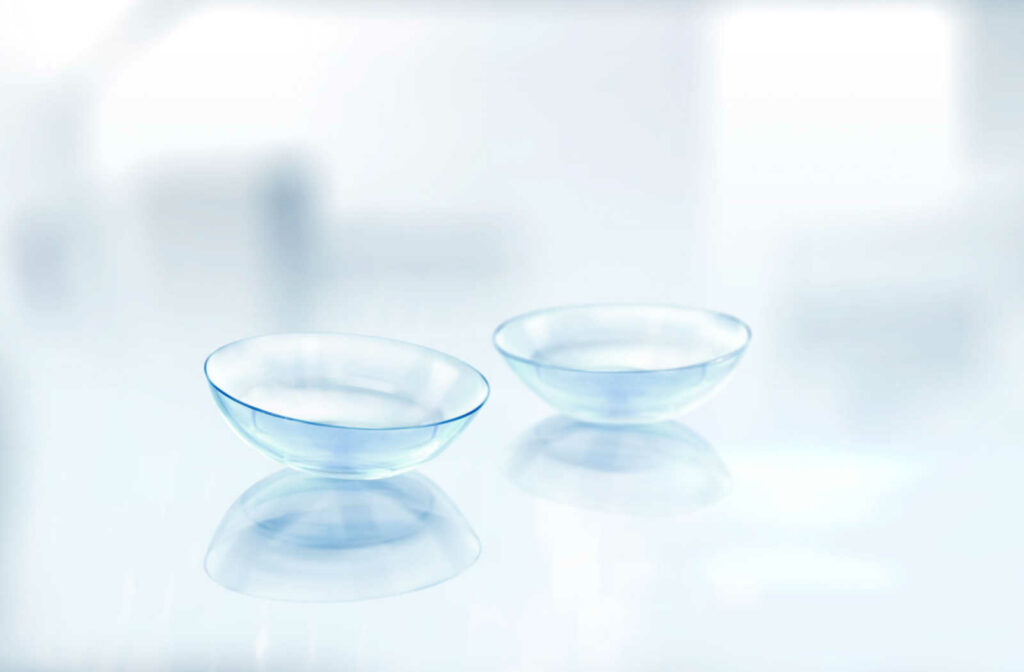There are different reasons that someone may need to wear contact lenses. It could be an inability to wear glasses, a dislike of wearing them, or preferring the convenience of contact lenses.
Corrective contact lenses are more accessible than before and can correct different visual problems. Your optometrist can tailor vision care for your specific needs. With a contact lens exam and fitting, they can help you decide which contact lenses work best for you.
Corrective Contact Lenses
A corrective contact lens, worn on the eye, helps light focus properly on the retina by bending the light before it enters the eye. Wearing corrective contact lenses also provides better peripheral vision compared to eyeglasses and treats the following refractive errors:
- Myopia or nearsightedness: Images close to you are clear, but images farther away are blurry. Light rays entering the eye bend incorrectly and focus images in front of the retina instead of on.
- Hyperopia or farsightedness: Images in the distance are clear, but close-up images are blurry.
- Astigmatism: The cornea isn’t completely round, so light bends more in one direction than in the other. It causes a blurred or distorted vision, which results in you seeing only certain parts of the image.
- Presbyopia: Is when the eye becomes less flexible or loses its ability to change focus to see a nearby object clearly. Presbyopia occurs as part of the aging process.
Types of Corrective Contact Lenses
There are different types of corrective lenses depending on the need. Corrective contact lenses come in:
- Disposable: Worn only once and discarded after.
- Daily wear: Worn during the day and stored in lens solution at night.
- Extended wear: Can wear for a longer time and at night.
Soft and hard are 2 common types of corrective contact lenses.
Soft Contact Lenses
Soft contact lenses are thin, made from flexible plastic, and cover the entire cornea. Some made with silicone hydrogels allow oxygen to pass through the lens to the cornea. They are also hydrophilic and water-absorbing.
Soft contact lenses are more comfortable and make adjusting to contacts easier than hard contact lenses. These contact lenses can correct farsightedness and nearsightedness. Toric contact lenses, specially designed to correct astigmatism, also correct other refractive errors.
Hard Contact Lenses
Rigid gas-permeable (RGP) contacts, made from hard plastic, are more durable and cover only part of the cornea. They also allow oxygen to reach the cornea but provide clearer vision than soft contact lenses.
Rigid gas permeable contact lenses are initially not comfortable and take some time to adjust to them. They can correct nearsightedness, farsightedness, astigmatism, and keratoconus. People with keratoconus have a thin, bulging cornea like a cone.

Other Corrective Contact Lenses
Monovision contact lenses correct two different things, one eye for close-up vision and the other for distance vision. Some people can have difficulty adjusting to monovision.
Multifocal contact lenses, used to correct myopia and presbyopia, have different rings or zones with multiple prescriptions in one lens. With multifocal, you can see near and far by selecting the right focus, but your vision is less sharp.
Bifocal contact lenses have two different prescriptions in one lens. One is for reading close up, and the other is for distant vision. They come in soft and hard contact lens materials.
Two types of bifocal contact lens designs include:
- Segmented bifocal: Distance prescription is in the top half of the lens, and near vision is on the lower part, mimicking bifocal eyeglasses.
- Concentric or simultaneous bifocal: The center has a distance or normal vision prescription, and the outer part has a near vision prescription.
Caring for Corrective Contact Lenses
Proper care of contact lenses is crucial to get the most out of them and increase their lifespan. Always clean and disinfect your lenses before using them and when storing them. Also, follow manufacturer directions and directions from your eye doctor.
Vision Correction with Contact Lenses
Contact lenses can correct many eye conditions, but they may not be suitable for everyone under certain circumstances. Your cornea and prescription can change, and regular contact lens exams allow your optometrist to determine the right lens and fit for you.
If you have any questions or concerns about your contact lenses, book an appointment with Pack & Bianes Vision Care Optometry today.



